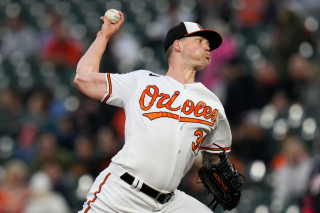Well I was not there and only saw a brief story or two on Tony Clark’s comments about use of pitchers. They were made at the World Series before the opening game on Friday.
Clark is the executive director of the Major League Baseball Players Association.
"The conversations that we've had with our players have suggested that unless or until you draw a line in the sand and force change, that the decision-makers on any one particular team are going to continue to make the decisions that they're making, which is have pitchers' - starting and relievers - max effort for the period of time that they can have them," Clark said at Dodger Stadium. “As soon as they seem to run out of gas, as the data suggests that they're going to, recycle them out and (move) to burn out another pitcher."
Because I have not seen many other quotes from Clark on this topic, I am not sure how he sees teams burning out pitchers. It is certainly not from use. Most starters are held often to about 100 pitches and teams pull starters often when they reach the third time through the batting order. Only four MLB pitchers even threw as much as 200 innings in 2024. Relievers are often held to one inning and seldom pitch more than two days in a row.
From this standpoint, teams are trying to protect pitchers and their investments in them.
But sure, pitchers must be encouraged to try and throw harder and improve spin rates on pitches – all that could be putting extra stress and pressure on their arms.
But what is the alternative? While other pitchers are spending winters at a pitching facility to improve velocity and improve their pitches, should another just sit home and preserve his arm?
That won’t get him very far and certainly could impact his performance, which then impacts his salary and attractiveness to a team when he is a free agent.
A pitcher who throws with big-time velocity has more margin for error when he fires a pitch. He could miss his spot and get away with it. That same pitcher might now also be a bigger injury risk.
Major League Baseball is, we are told, constantly researching the pitcher injury issue and studying it. But the issue is complex obviously and not easy to answer or resolve.
The Orioles can tell people all about that. Kyle Bradish, John Means and Tyler Wells combined to make just 15 starts last season. Grayson Rodriguez made 20 – none after July 31.
In MLB, pitchers no longer throw in four-man rotations like in Jim Palmer’s day and they go in five-man rotations. And teams often look to get them extra rest. They are trying to help them out.
But if more velocity and more spin is putting stress on arms, elbows and shoulders, what is a team to do? Tell their pitchers not to work to get better when the other 29 teams are doing so?
Game 1 TV ratings were strong: According to Sports Media Watch, Game 1 of the World Series on Fox television averaged 15.2 million viewers across all platforms. That was up 62% from last year’s Diamondbacks-Rangers Game 1 (9.35M), up 30% from Phillies-Astros two years ago (11.68M) and the most-watched World Series opener since Astros-Dodgers in 2017 (15.33M). The previous high over that span was a combined 14.33 million for Dodgers-Red Sox in 2018.
Cowser is top AL rookie: Orioles outfielder Colton Cowser, who produced a .768 OPS with 24 homers, won the American League Players Choice award for Outstanding Rookie. The award is voted on by players and presented by the Major League Baseball Players Association.
Cowser is the third Oriole in four years to be so honored by the MLBPA following Ryan Mountcastle in 2021 and Gunnar Henderson in 2023. Adley Rutschman was a 2022 finalist.
The Baseball Writers' Association of America honor, the so called official award, will be announced Nov. 18.
Click here for a video announcing the award.
By accepting you will be accessing a service provided by a third-party external to https://www.masnsports.com/





